Existing User Log In
New User Registration
Register for a free account to gain full access to the VGChartz Network and join our thriving community.



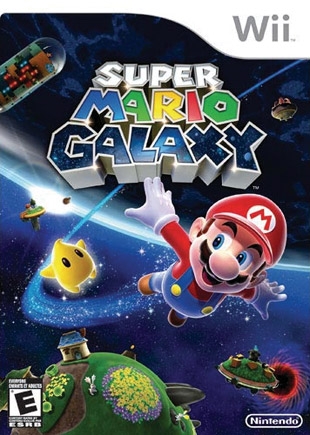

America - Front
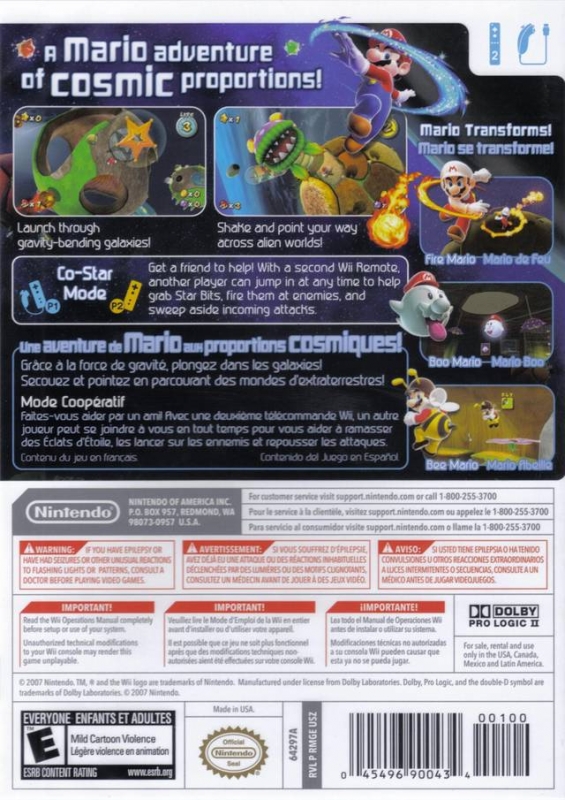

America - Back

Once upon a time, a little plumber arose from the depths of the Mushroom Kingdom to save the princess from the evil dragon. To accomplish this he traversed many fantastic lands - running, jumping on enemies’ heads, grabbing powerups and traversing dangerous platforms. That game, Super Mario Bros., is commonly heralded as one of the best games ever and was until very recently the most-owned console game on the planet. Fast forward to 2007. In Super Mario Galaxy Princess Peach is again captured by Bowser and, ever the hero, Mario embarks on an epic adventure to save her. The difference? This time she’s been taken into space.
In chasing after them Mario is knocked unconscious and awakens on a small, dream-like planet. Here he must chase and catch three rabbits who promise to tell him where he is. This is a subtle way of showing off Mario Galaxy’s central new gimmick - gravity. Mario can do a running jump off the side of the planet only to have its gravity pull him back on the other side, opening up enormous gameplay potential.
After catching the rabbits Mario is soon taken to a space station called the Comet Observatory. Here he meets baby-like star creatures called Lumas and their ‘mother’ Princess Rosalina. They eternally fly around the galaxy and Rosalina nurtures the Lumas until they are old enough to become planets. Unfortunately a confrontation with Bowser has caused them to lose their supply of the station’s source of power: stars. If Mario is to reach the center of the universe and rescue Peach, he must first travel to many unique and beautiful worlds to recover enough stars to power the Observatory. And so, the real game begins.
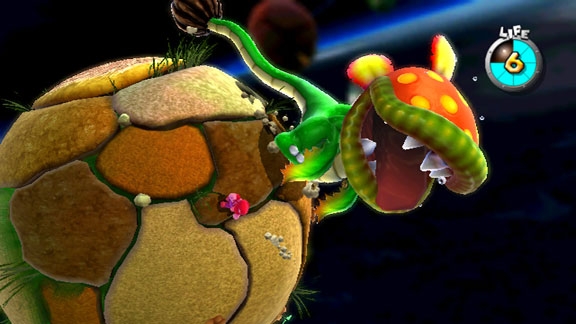
And what a game it is! Controlling with his trademark grace and fluidity, Mario uses classic moves like the Triple Jump, Long Jump, Spin Attack and Butt Stomp to make his way through imaginative planets, beating down enemies new and old while traversing some of his most difficult platforming segments since the Super Nintendo days. Now, before I go any further about gameplay specifics, it simply must be mentioned just how much of a joy the experience of playing Mario Galaxy is.
Visually, the game is absolutely stunning. Its bright, bouncy primary-colour design evokes a living children’s storybook. Mario animates with such fluidity and pep that you just want to pinch his little cheeks. The worlds he explores are just as vibrant. Plucky little bees covered in fur effects bop around the Honey Hive Galaxy. Angry, shiny Bullet Bills will chase him around nostalgia-inducing airships relentlessly. The vast expanse of space is constantly visible, with small planets somewhere in the background hinting at adventure just around the corner.
From a technical standpoint there’s almost nothing to mention. The framerate stays at a rock-solid 60 FPS throughout, even during boss battles with huge enemies with lots of effects onscreen. The one gripe I’ve got with the technical side of the graphics is that a few enemies could use a few more polygons. Though everyone animates very smoothly, a few enemies such as Monty Mole clearly have a few rough edges that would have done well with a little smoothing over.
The visuals in Mario Galaxy are beautiful, no doubt. That said, where Nintendo has truly outdone itself is in the game’s audio. While he’s definitely the strong silent type, Mario’s various exuberant utterances work well toward keeping the player energized. His "HA! WAH! YAHOO!" when performing a triple jump never fails to incite a smile. When an asteroid crashes into a planet the resulting "boom", combined with controller rumble, makes you feel that impact. The Wii remote’s speaker is used to good effect as well, twinkling after you shoot a star bit (more on those later) or swooshing to let you know that your Spin Attack has been recharged.
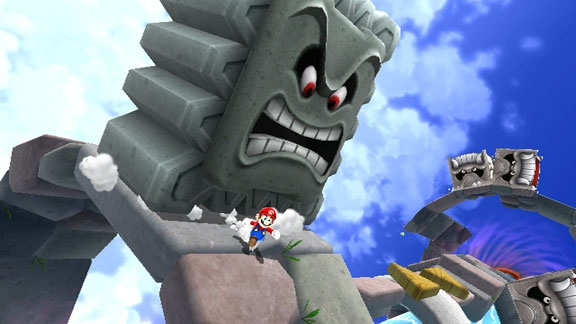
With regard to the soundtrack Koji Kondo, the series’ celebrated composer, has pulled out all of the stops - putting all of his effort into an extremely varied orchestral soundtrack. I challenge you - nay, I dare you - to hear the opening soundtrack and not at least think about shedding a tear. The Honey Hive soundtrack brims with life, the ghost levels sound eerie and mischievous and the boss music really pumps you up. Without a doubt, the best soundtrack in the series’ storied history.
As mentioned, it’s an absolute joy to guide Mario through his latest adventure. The worlds he explores combine tried-and-true jumping mechanics with many new and absorbing innovations. Leaping around an entire planet and ending up back where you started never gets old, and nor does swinging yourself between two completely different gravity fields. This mechanic is used very thoughtfully to create challenging obstacle courses for Mario. For example, in one level he is on a disc-shaped ‘planet’ that’s moving through a barrage of cannonballs and lasers which he can only avoid by making strategic use of the top, bottom and sides of the planetoid.
The levels are each packed with challenges like this, which must be completed in order to advance to the next small planetoid and eventually to your goal of the level’s star. One minute you may be on an asteroid, collecting the pieces of a star that will warp you to the next area while trying to avoid being sucked up by a black hole, and the next you’ll find you must spin your enemies into glass cages, destroying them and releasing the poor Lumas trapped inside. It’s all very rewarding and this sense of guidance through the levels eliminates the chief problem other 3D Mario games have been accused of - a lack of guidance in their large worlds.
The Boss levels in Super Mario Galaxy are exciting and varied. From climbing on the back of a massive machine, Shadow of the Colossus-style, to using the Spin Attack to take on an angry spinning top, the new enemies fit in just fine. However, the battles with returning foes are the stars here. The player encounters Baby Bowser and Kamek aboard airships that should be familiar to any fan of Super Mario Bros 3, and figuring out and executing plans of attack are quite rewarding, indeed. But what everyone really cares about in a Mario game are the fights with Bowser, right? Never fear, the gravity-defying fights with Mario’s menacing arch-nemesis on a small planet will be looked on as fondly as those that took place on the floating platforms in Mario 64 - truly epic confrontations that usually only exist in a fan’s dreams.
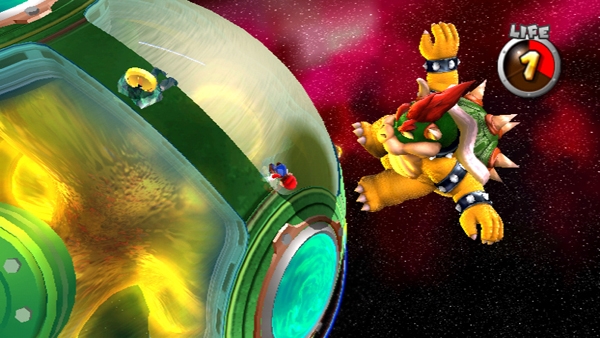
One of the main attractions of any Mario title is the powerups our hero can don, and Galaxy does not disappoint in this regard. The Bee Suit turns the plumber into a plucky little insect, allowing him to hover over gaps, climb honeycomb and walk on light objects such as flowers. The Spring Suit allows Mario to bounce to extreme heights, at the expense of a loss of control. The classic Fire Flower makes its first appearance in a 3D game, allowing you to pulverize enemies and melt ice. The new Ice Flower allows you to run on water, opening up new areas for you to explore. Finally the Red Star, accessible from the Observatory after beating the game, allows Mario to fly around and just take in the space station’s pure beauty.
One little curiosity with the game is the lives system. Like all the Mario platformers before it, you can only die a certain number of times before being hit with the dreaded 'Game Over' screen. However, the purpose of the lives is negated when extra ones are doled out like candy. There are at least five hidden throughout the observatory that you can collect every time you return, and Toad will give you another five just for talking with him. Even in the levels themselves most of the difficult sections have a freebie available at their outset, allowing you to continue as long as you want. And if you do fail at a particular segment enough times to hit the 'Game Over' screen of death? A slap on the wrist, and you must restart the current level. It’s great that Nintendo wants to keep gamers from getting frustrated, and it shouldn’t affect anyone’s opinion of the game, but it does make one wonder why the system was even implemented in the first place.
As mentioned before, controlling Mario is a relatively simple affair. Any fan of Mario 64 or Sunshine will feel right at home. The control stick moves around, A on the Wii Remote jumps and the Z button crouches. These can be combined in various ways to perform backflips, double and triple jumps, butt stomps, etc.
Being one of Nintendo’s premiere Wii games, motion control must be well-integrated, right? In a word, definitely. There are two primary uses of the Wii Remote’s extra capabilities that are used pretty much everywhere. To perform a Spin Attack all that’s required is an intuitive shake of either the Wii-mote or the Nunchuk. This is a very tactile move, and it feels like you are physically spinning into that enemy yourself.
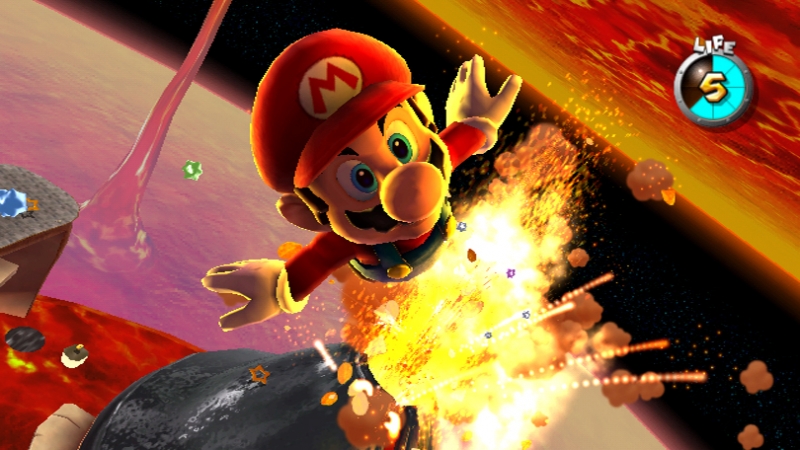
The second primary method of motion control utilizes the remote’s pointer. Colorful little balls called Star Bits populate each of the game’s worlds. These are used as both projectiles and currency. Simply point at them to pick them up. To fire at enemies, just aim at them and press the B trigger to fire and stun them. At some points, in levels and in the Observatory overworld, you’ll encounter Hungry Lumas who will either give you a powerup or make a new planet for you in exchange for a certain amount of Star Bits.
It’s worth noting that the Star Bits constitute the game’s only real ‘multiplayer’ mode. Called Co-Star mode, this mechanic allows a second player to pick up a remote at any time and collect and fire their own Star Bits to help the main player. They can also grab enemies, holding them for the player to run up and hit. While it’s a pity that the game doesn’t include a ‘true’ multiplayer mode this is a great way to allow your non-gaming friend to help you out, or for two younger people to work through the game together.
In addition to those methods there are many context-sensitive uses for the various motion-sensing capabilities. In order to progress in some levels Mario must make use of paths of special stars that suck him in when pointed at and clicked on with A. There are also many tilt-based sections, such as Manta Ray racing and balancing on a ball, which add unnecessary but welcome variety to the gameplay.
I do have two small complaints about the controls. When jumping between different gravity fields while running forward Mario’s orientation changes which may, for example, cause him to run to the right while you hold the analog stick to the left. This is slightly disorienting and can cause you to get sucked up by a black hole. This is easily rectified by immediately releasing the analog stick for a moment when you switch gravity fields. The other problem with the controls relates to camera movement - specifically, the lack of it. In most cases the player has no direct control over the game camera. Once in a while, in more open spaces, the D-Pad can be used to rotate the view but these are the areas that generally don’t require it. This isn’t a huge issue though, as the camera generally does a respectable job of showing you what you need to see.
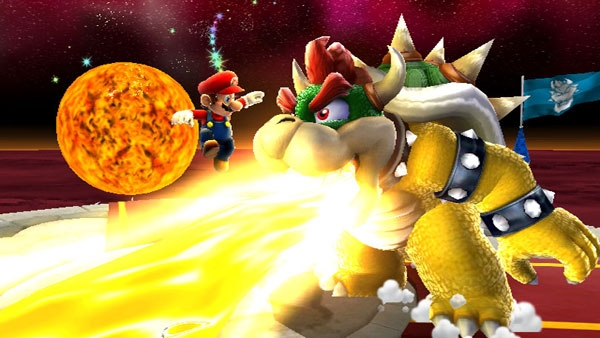
Another small problem with the camera relates to when running around the different sides of planets. If you stand at the top of a planet and run away from the camera to the bottom, the controls invert. Pushing to the right on the analog stick at this time will make Mario run to HIS right, but not necessarily to yours. As with most 3D adventure games there can be similar problems with the swimming controls. Just as with the problem when jumping between gravity fields, this is easily remedied by momentarily letting go of the analog stick.
Aside from the opening and closing cutscenes, little of the story is mandatory to watch. That said, interested players can learn more about the backstory of Rosalina, the Lumas and the Comet Observatory by having chapters of a book read to you by Rosalina herself in the station’s library. These are unlocked as you collect more and more stars. The watercolor paintings, innocent story of a child’s discovery, flipping pages and soothing lullaby music really make these optional periods feel more like ‘story time’ than a video game.
Anyone looking for a game with lots of value for their money should definitely consider Super Mario Galaxy. Even after completing everything a level has to offer there are plenty of reasons to go back to it. At random times a comet will land on a planet, offering you a difficult new challenge in exchange for a star. Additionally, you’ll sometimes get letters from Luigi (on your Wii Message Board, no less!) telling you he’s gotten lost and giving you a picture of his whereabouts, leaving you to discover where in the game he is by yourself. While only 60 stars are required to go to the centre of the universe and fight Bowser there are 120 in total. The difficulty of the second half of stars ramps up considerably compared to the relatively easy first batch. Some stars take ten minutes to get, while others will have you throwing your controller at the TV with exasperation after dying the 20th time. This means that the casual player or young child will be able to complete the core game, but the enthusiast may spend weeks unlocking every bonus level from Hungry Lumas, getting every single star and beating the next-to-impossible Trial Galaxies (unlocked by finding the three Green Lumas).
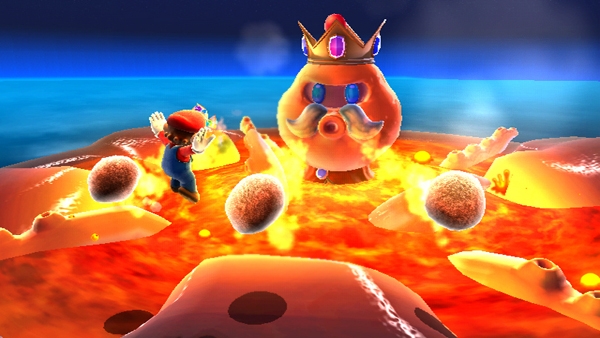
But once you get all the stars, you’re done, right? The game has nothing left to offer? Wrong. No sooner does Mario collect the last star and watch the credits roll than you unlock an alternate version of the entire game which supposes that Luigi is the one to rescue the princess! Essentially the game’s Hard Mode, Luigi has less traction than Mario while running, and doesn’t jump as far, but he can jump higher and he’s ‘floatier’. Luigi must go through the entire game, collecting the same stars (even rescuing himself), and then there’s a bonus star that Mario had no access to. For completionists, that’s a grand total of 242 stars in the game. On top of all that, like all Mario platformers, it’s just a joy to boot up and run around for a little while, regardless of if you have a goal or not.
All in all, Super Mario Galaxy is the epitome of Nintendo’s philosophy that games can appeal to everyone. Nintendo legend Shigeru Miyamoto has truly crafted his best work ever. The controls are great, the innovations are many, the visuals are fantastic, the music is awe-inspiringly beautiful and it’s very refreshing to see such a well-done game that forgoes the current norms in the industry and just focuses on being fun. Sure, there are a few small issues with the controls, and a multiplayer mode akin to the one in Super Mario 64 DS would have been appreciated - the game’s not perfect. But, in my humble opinion, it’s just about as close as any game has ever gotten and it's one of Nintendo's brightest stars.










|
|
|
|
|
|
|
|
|
|
|
|
|
|
ljlrj
posted 25/06/2014, 11:54
http://www.nintendo.co.jp/ir/en/sales/software/wii.html >:l very heavyundertrack Message | Report |
|
|
|